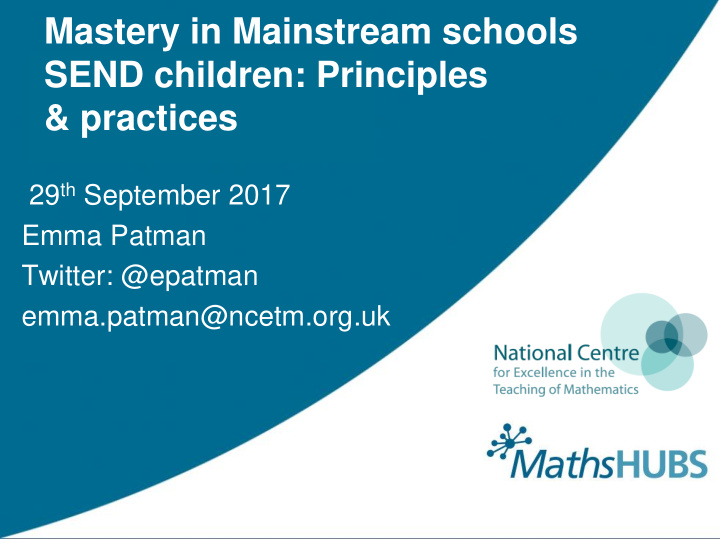



Mastery in Mainstream schools SEND children: Principles & practices 29 th September 2017 Emma Patman Twitter: @epatman emma.patman@ncetm.org.uk
Let’s look at some maths! From www.nrich.org.uk KS1 Task Discuss: How would you modify the activity for it for a child you know with SEND?
Defining SEND.. • Impossible to define all children and all of their needs.
SEN Code of Practice 2014 (updated 2015) 6.12 All pupils should have access to a broad and balanced curriculum. The National Curriculum Inclusion Statement states that teachers should set high expectations for every pupil, whatever their prior attainment. Teachers should use appropriate assessment to set targets which are deliberately ambitious. Potential areas of difficulty should be identified and addressed at the outset. Lessons should be planned to address potential areas of difficulty and to remove barriers to pupil achievement. In many cases, such planning will mean that pupils with SEN and disabilities will be able to study the full national curriculum
A pupil has SEN where their learning difficulty or disability calls for special educational provision, namely provision different from or additional to that normally available to pupils of the same age. Making higher quality teaching normally available to the whole class is likely to mean that fewer pupils will require such support. Such improvements in whole-class provision tend to be more cost effective and sustainable.
6.36 Teachers are responsible and accountable for the progress and development of the pupils in their class, including where pupils access support from teaching assistants or specialist staff. 6.37 High quality teaching, differentiated for individual pupils , is the first step in responding to pupils who have or may have SEN. Additional intervention and support cannot compensate for a lack of good quality teaching . Schools should regularly and carefully review the quality of teaching for all pupils, including those at risk of underachievement. This includes reviewing and, where necessary, improving, teachers’ understanding of strategies to identify and support vulnerable pupils and their knowledge of the SEN most frequently encountered.
3 types of mathematical knowledge Factual – I know that….. Procedural – I know how Conceptual – I know why.. and I know these are related so I can use this……
Factual knowledge • Requires memory skills • The automatic retrieval of basic maths facts is important to solving mathematical problems • If facts cannot be recalled, this requires an extra level of calculation in more complex problems Can you share some good examples of how we can overcome this when working with children who have difficulty with this?
Procedural knowledge • Some argue that when we learn a method, we don’t need to understand • But if depth and application are to be achieved, at any level, we need a balance of procedural and conceptual knowledge • Can you share some good examples of how we can overcome this when working with children who have difficulty with this?
Conceptual knowledge • Often the most difficult to acquire because it involves building on other concepts • Lack of conceptual understanding leads to misconceptions and being unable to apply in other situations • Can you share some good examples of how we can overcome this when working with children who have difficulty with this?
Which of these additions is likely to cause some children the most cognitive Overload? Pause for thought … Discuss! With thanks to Jane Jones HMI
Teaching for Mastery: The 5 Big Ideas • Access • Chains of Reasoning • Pattern • Making • Making Connections Connections Representation Mathematical Thinking & Structure Small steps are Coherence easier to take Variation Fluency • Procedural • Number Facts • Conceptual • Table Facts • Making • Making Connections Connections
Your professional judgement • High expectations for all • What are you doing to help children keep up with their peers? • How can you remove barriers to learning? • What mindsets might need shifting?
A possible model…… • All learners begin lesson together • Children work in pairs or small groups with children who are more / less confident • Children who need it are provided with scaffolds • Teaching assistant more general role • Adults decide IF/ WHEN a child needs to move to more personalised learning
Intervention • If intervention is needed, ideally it would be with the teacher • Could be pre-teaching • Could be within the lesson / practice time with another adult supervising the rest of the children • Could be after the lesson – as soon as possible and should be the same day
Case studies from schools Are gaps in knowledge because of SEN or another reason? SEN does not always mean lower attaining
The Role of Teaching Assistants
Pupil progress shouldn’t be confused with curriculum pace: good progress in mathematics is not about moving on quickly Vanessa Pittard , May 2017
Benefits • True inclusion • No pre-conceptions of how they will respond • Higher self esteem • Two way respect & role models • Learning from each other • Small steps beneficial • Repetition helpful • Time to practice, deepen
Please remember…… 3. Some children, who feel confident, will be let loose. They’ll be able to explore deeper into the woods, before returning to the group to continue on with the journey. 2. Some 4. Children will children will not be racing off need a little ahead on a additional different support along journey. the way 5. Children will not be left behind 1. We ALL alone and start the isolated. journey TOGETHER Maths Hunt
Recommend
More recommend